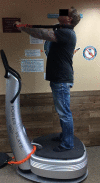Alleviation of posttraumatic dizziness by restoration of the cervical lordosis: a CBP® case study with a one year follow-up
- PMID: 29765191
- PMCID: PMC5940483
- DOI: 10.1589/jpts.30.730
Alleviation of posttraumatic dizziness by restoration of the cervical lordosis: a CBP® case study with a one year follow-up
Abstract
[Purpose] To present the successful treatment of posttraumatic dizziness and neck pains that were initiated in a patient following a whiplash event. [Subject and Methods] A 46 year old male suffered a whiplash event that initiated neck pain and dizziness symptoms. The patient had many positive orthopedic findings and demonstrated a forward head posture and cervical hypolordosis. The patient was treated by Chiropractic BioPhysics® technique including cervical extension traction, extension exercises and spinal manipulative therapy initially three times a week for 16-weeks, and once a month thereafter. [Results] The patient had a resolution of daily dizziness and neck pain with a concomitant reduction of forward head translation and increase in cervical lordosis. The postural measures were further improved after one year of mostly home-care. [Conclusion] The cervical spine alignment may be an important biomarker for those with dizziness. The correction of cervical lordosis may be an essential requirement for superior clinical outcomes for those with posttraumatic dizziness.
Keywords: Cervical lordosis; Extension traction; Posttraumatic dizziness.
Figures



Similar articles
-
Restoring cervical lordosis by cervical extension traction methods in the treatment of cervical spine disorders: a systematic review of controlled trials.J Phys Ther Sci. 2021 Oct;33(10):784-794. doi: 10.1589/jpts.33.784. Epub 2021 Oct 13. J Phys Ther Sci. 2021. PMID: 34658525 Free PMC article. Review.
-
Structural rehabilitation of the cervical lordosis and forward head posture: a selective review of Chiropractic BioPhysics® case reports.J Phys Ther Sci. 2022 Nov;34(11):759-771. doi: 10.1589/jpts.34.759. Epub 2022 Nov 1. J Phys Ther Sci. 2022. PMID: 36337218 Free PMC article. Review.
-
The treatment of dizziness by improving cervical lordosis: a Chiropractic BioPhysics® case report.J Phys Ther Sci. 2020 Dec;32(12):864-868. doi: 10.1589/jpts.32.864. Epub 2020 Dec 11. J Phys Ther Sci. 2020. PMID: 33362360 Free PMC article.
-
Cervical extension traction as part of a multimodal rehabilitation program relieves whiplash-associated disorders in a patient having failed previous chiropractic treatment: a CBP® case report.J Phys Ther Sci. 2018 Feb;30(2):266-270. doi: 10.1589/jpts.30.266. Epub 2018 Feb 20. J Phys Ther Sci. 2018. PMID: 29545691 Free PMC article.
-
The effect of normalizing the sagittal cervical configuration on dizziness, neck pain, and cervicocephalic kinesthetic sensibility: a 1-year randomized controlled study.Eur J Phys Rehabil Med. 2017 Feb;53(1):57-71. doi: 10.23736/S1973-9087.16.04179-4. Epub 2016 Aug 30. Eur J Phys Rehabil Med. 2017. PMID: 27575013 Clinical Trial.
Cited by
-
Re-establishing the cervical lordosis after whiplash: a Chiropractic Biophysics® spinal corrective care methods pre-auto injury and post-auto injury case report with follow-up.J Phys Ther Sci. 2023 Mar;35(3):270-275. doi: 10.1589/jpts.35.270. Epub 2023 Mar 1. J Phys Ther Sci. 2023. PMID: 36866005 Free PMC article.
-
Restoring cervical lordosis by cervical extension traction methods in the treatment of cervical spine disorders: a systematic review of controlled trials.J Phys Ther Sci. 2021 Oct;33(10):784-794. doi: 10.1589/jpts.33.784. Epub 2021 Oct 13. J Phys Ther Sci. 2021. PMID: 34658525 Free PMC article. Review.
-
Examining Clinical Opinion and Experience Regarding Utilization of Plain Radiography of the Spine: Evidence from Surveying the Chiropractic Profession.J Clin Med. 2023 Mar 10;12(6):2169. doi: 10.3390/jcm12062169. J Clin Med. 2023. PMID: 36983168 Free PMC article.
-
Structural rehabilitation of the cervical lordosis and forward head posture: a selective review of Chiropractic BioPhysics® case reports.J Phys Ther Sci. 2022 Nov;34(11):759-771. doi: 10.1589/jpts.34.759. Epub 2022 Nov 1. J Phys Ther Sci. 2022. PMID: 36337218 Free PMC article. Review.
-
Investigation of spinopelvic sagittal alignment and its correlations in asymptomatic pediatric populations.Sci Rep. 2025 Feb 26;15(1):6847. doi: 10.1038/s41598-025-91481-3. Sci Rep. 2025. PMID: 40011699 Free PMC article.
References
-
- Hogue JD: Office evaluation of dizziness. Prim Care, 2015, 42: 249–258. - PubMed
-
- Byrne M: Assessment of the dizzy patient. Aust Fam Physician, 2002, 31: 722–727. - PubMed
-
- Fitzgerald DC: Head trauma: hearing loss and dizziness. J Trauma, 1996, 40: 488–496. - PubMed
-
- Spitzer WO, Skovron ML, Salmi LR, et al. : Scientific monograph of the Quebec Task Force on Whiplash-Associated Disorders: redefining “whiplash” and its management. Spine, 1995, 20: 1S–73S. - PubMed
-
- Grauer JN, Panjabi MM, Cholewicki J, et al. : Whiplash produces an S-shaped curvature of the neck with hyperextension at lower levels. Spine, 1997, 22: 2489–2494. - PubMed
Publication types
LinkOut - more resources
Full Text Sources
Other Literature Sources
